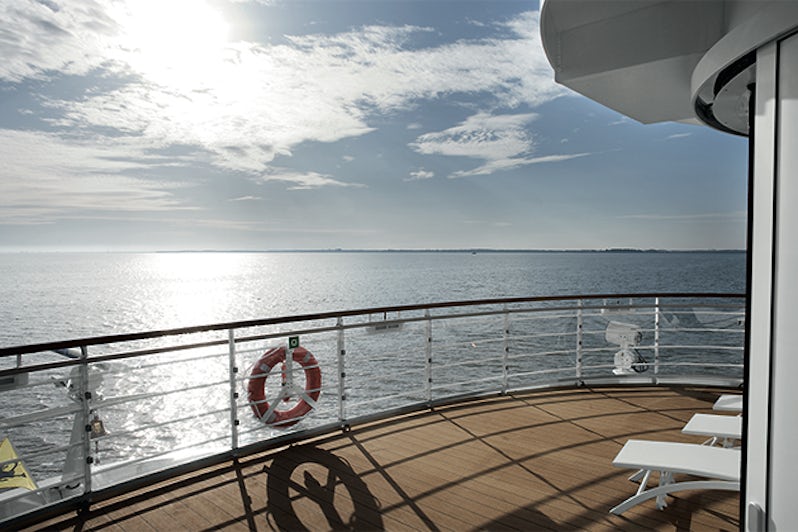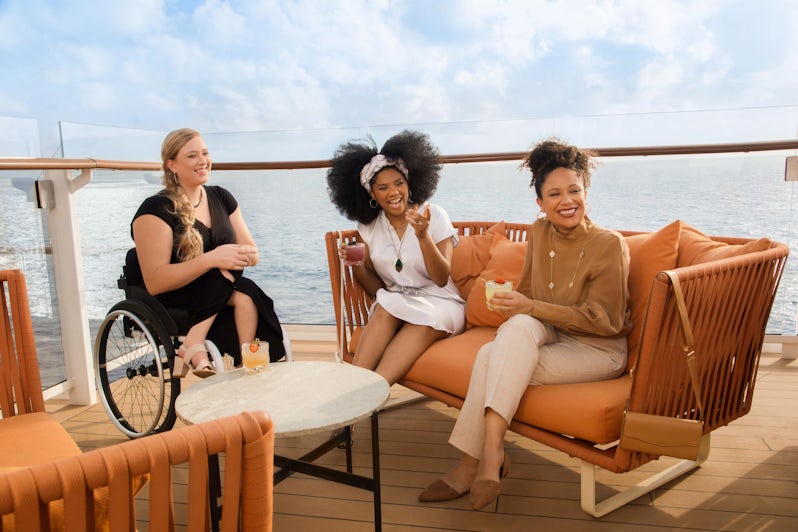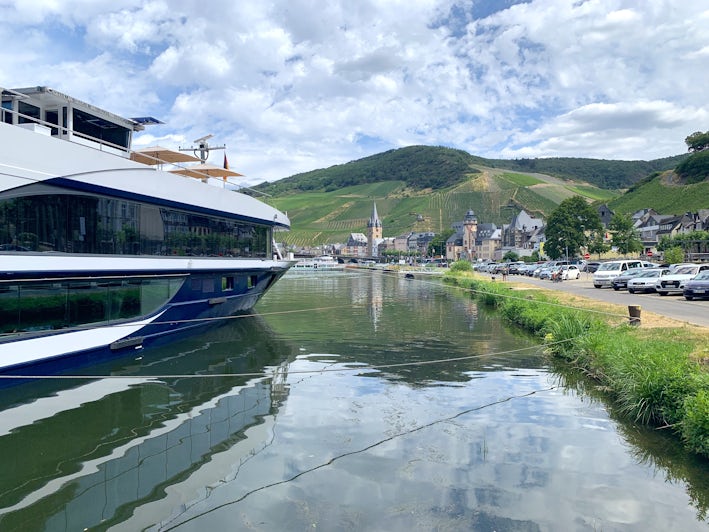
A Guide to Accessible River Cruises



Accessible river cruising is certainly doable, but the logistics involved require a bit of inside knowledge regarding what is and is not possible for those cruising with mobility challenges.
There’s a lot to consider, starting with the cruise cabin itself, and continuing through the ports your ship will visit. Will you be able to take advantage of the value of included excursions? How will you navigate potentially steep gangways? Are European river cruises easier to manage in terms of accessibility than other countries?
Armed with the right information about specific cruise lines and destinations, you can find a river cruise that provides an enjoyable and satisfying experience. It pays to do your homework; to get you started, here is our guide to accessible river cruising.
Choose the Right River Ship For Accessibility by Asking the Right Questions

It's sometimes hard to find detailed ship information about facilities for passengers who use mobility aids, like walkers and wheelchairs, on cruise line websites and in their brochures. River ships might look similar on the outside, but they can be very different on the inside.
If you're concerned about how mobility issues will impact your enjoyment of a river cruise, make sure you ask about the following areas before booking.
Cabin Size and Configuration
River cruise cabins are much smaller than hotel rooms, and not every river ship offers accessible staterooms. Several lines offer a small number of accessible or modified staterooms with wide doors, but these might not be available on all of their ships. You'll want to know if it's easy to open the door and go inside with a wheelchair, and if there is enough space to store mobility devices.
Accessible Bathrooms
Although it's rare to find bathtubs, as on all cruise ships, river ship bathrooms can vary. Some shower stalls have fixed doors with limited access, while others have handy doors that fold back to create one large area of bathroom space. Many bathrooms have raised floors, requiring modifications to make them wheelchair accessible. When in doubt, ask.
Elevators On Board
Most modern ships have elevators, but they vary in the number of decks they serve. River vessels must pass beneath bridges, so the sun deck may only be accessible by stairs. Some vessels (notably Uniworld’s Super Ships) have a special chair lift to take passengers unable to navigate stairs to the top deck, but such lifts are still rare.
Gangways on River Ships
Getting on and off river cruise ships can be tricky for cruisers with mobility challenges. Sometimes two or three ships are moored alongside each other, so passengers on the outermost vessels must cross over narrow gangways that link the ships together -- usually on the sun deck or atrium level -- and negotiate stairs to get ashore. It is very difficult for lines to guarantee that these "rafted" moorings will not take place during a cruise.
Most lines specify that wheelchair users should be accompanied by someone who can assist them with embarkation and disembarkation. Despite this official line, crewmembers will often lend a hand -- but this can never be guaranteed as river vessels have a relatively small number of staff. You do not want to book a cruise only to find out that you cannot board -- or that once on, you can't get off in port.
Cruise Critic found that during a recent Napa River Area cruise onboard American Jazz, crew members were available to assist those with mobility concerns on and off the ships at all times, but that may not always be the case on all river cruise lines.
Plan for Excursions That Match Your Mobility Requirements

As some daily excursions on river cruises are generally included in the cruise fare, you won't get value for money if you can't join many of them. Usually, there are some options for wheelchair users and passengers who can navigate a few steps and go on short walks, but not every tour or attraction will be available to you.
Because Europe's rivers are historic working waterways, many important cities and wine-growing towns line the banks. This is good news for travelers with disabilities because it means that museums, churches, shops, restaurants and other attractions are usually very close by for both tours and independent exploration, with no need for bus transfers.
Look for cruise lines that grade their guided walking tours according to fitness levels; slower walks that don't involve any steps are usually suitable for people using wheelchairs and with restricted mobility (as we noted on AmaSerena).
Also rely on the cruise director to advise which tours are suitable for different levels of mobility. They will be able to suggest places where passengers can rest or see alternative attractions with easier access.
For longer trips involving bus travel, coaches may not be adapted for wheelchair use, so passengers need to be able to lift wheelchairs and mobility aids onto the bus (or rely on crew members to stow them in the luggage compartment) and be able to climb the steps onto the vehicle.
And don’t be afraid to ask if you can join a bus or walking tour via a taxi or rideshare. You may miss out on some of the guide’s talks along the way, but still get to see the primary attraction. This is particularly a good idea if the attraction is a food, beer or wine tasting.
If tours don't suit, the proximity of town centers to the docking spots make it relatively easy for independent passengers to explore by themselves, especially as many waterfronts beside the river are very flat and have places to stop for a drink or snack. However, as the price of many tours is included in the cruise fare, it'll be up to you to decide if the trip is worth the money if you can't participate in tours.
Pick the Itinerary That Gives You the Most Accessible Options

A highlight of river cruising is the ever-changing panorama of spectacular scenery, much of which can be admired from the ship. For passengers with severely restricted mobility, itineraries that cover longer distances with plenty of cruising time may be an idyllic way to see the sights by simply staying onboard.
River cruising in the U.S. offers an abundance of accessible port choices. ADA laws make attractions and sidewalks lining city streets accessible. Even in the French Quarter of New Orleans, which is a popular starting and ending point for Mississippi River cruises, the sidewalks, crosswalks and streetcars are ADA compliant with wheelchair lifts.
Top European options are sailings on the Rhine River and Danube River. Highlights include a day cruising along the UNESCO-listed Middle Rhine, lined with castles and famous for the Lorelei Rock where a legendary siren is said to have lured passing sailors to their doom -- all visible from the deck of the ship.
The Wachau Valley, also on the UNESCO World Heritage list, is a dramatic stretch of the Danube between the Austrian towns of Krems and Melk. And the wine-growing region along the Mosel River in Germany provides stunning scenery.
The main lines also offer 15-day cruises from Budapest to Amsterdam along the Rhine, Main and Danube, providing a very easy way to take in five countries compared to the hassle of land-based travel on a similar itinerary.
Countries such as France and Portugal are undeniably beautiful too, but itineraries clock up fewer river miles between ports. That means passengers don't see as much scenery if they choose to stay onboard while other passengers go on shore excursions.
The shore trips on northern France cruise itineraries often include full days at major sights such as the Normandy landing beaches and other Second World War landmarks, with long bus journeys to reach them, so they are not suitable for full-time wheelchair users who can't climb the steps into the coach.
Cruises through the wine-growing regions of southern France may be better suited to guests with disabilities as they stop in interesting towns and cities (including Macon, Lyon and Avignon) that can be explored without the need for a coach transfer.
It pays to study the itinerary and excursions carefully before booking to determine how much you'll be able to do and whether you might need to skip key attractions.
Accessible River Cruise Details By Cruise Line

If you're considering a cruise on one of the major cruise lines, here's how they stack up when it comes to accessible travel. Feeling overwhelmed? Ask a knowledgeable travel agent -- particularly one who specializes in river cruising or cruise travel for people with disabilities -- to help you find the ship and trip that's right for you.
Accessible U.S. River Cruise Lines
For U.S. based cruisers, cruising U.S. waters comes with the added benefit of easier travel to and from the ship’s departure and debarkation ports. Driving to ports might be possible in many cases but flying within the U.S. reduces the travel challenges in most cases when compared to international flights.
American Cruise Lines: ACL offers 17 river and coastal ships sailing wholly within U.S. waters, so no passport is required. Ships are designed and managed with an older demographic in mind, including those with mobility challenges.
Staterooms are large, with doors wide enough to accommodate assistive devices. Elevators access all but the upper decks on most ships. All staterooms include panic buttons. All ships have wheelchair accessible staterooms available.
Crew members are almost always on hand to assist on gangways and the line’s tour coaches. Drivers help by loading mobility devices into the luggage compartment. If lifts are not available, alternative transportation arrangements can often be made so full-time wheelchair users who are unable to board with assistance can still enjoy the tours.
Itineraries include the Mississippi River, Columbia River and Snake River, as well as the Intracoastal Waterway on the East Coast, plus coastal bays, and rivers on both coasts, including San Francisco Bay (along with the San Joaquin, Sacramento and Napa Rivers), Puget Sound, and Chesapeake Bay. ACL also offers an extended, 20-state, 60-night multi-river cruise.
American Queen Voyages: AQV operates seven vessels, including four paddlewheel river ships, two ocean and lake ships, and one expedition. The river ships all have wheelchair accessible staterooms along with elevators serving all but the top decks. Many excursion buses feature lifts, and crew members are available to assist on gangways.
River itineraries include sailings of various lengths on the Mississippi, Ohio, Cumberland and Tennessee Rivers, as well as on the Columbia and Snake Rivers in the Pacific Northwest.
Viking River: Viking Mississippi the first ship in the American fleet for the Viking line. It features many of the familiar touches found on the line’s European river ships, but with American twists. Sailing in American waters means the line must adhere to ADA standards, so all ships in its American fleet will include accessible staterooms. Elevators on the Mississippi access all decks.
Itineraries are all on the Mississippi River, varying in length from eight to 22 days.
Non-U.S. Accessible River Cruise Lines

AmaWaterways: The line’s website states wheelchair accessibility is very limited in its European fleet, stressing the gangway problem.
Every ship in the European fleet has an elevator that serves all floors except the lower deck and sun deck. Crewmembers will assist any passengers with disabilities to the top deck, and help them at any other time onboard, subject to availability. No elevators are available on the line’s ships serving Asia, Africa and Egypt.
It is strongly recommended that passengers with mobility disabilities travel with a cruise partner who can assist them on tours and with getting on and off the ship. Many shore excursions are accessible for passengers with limited mobility.
A-Rosa: The German-owned line offers one cabin suitable for passengers with limited mobility on A-Rosa Viva -- one of its "international" ships that have dedicated English-speaking hosts. With prior notification, passengers can bring their own wheelchairs and mobility aids onboard. Medical oxygen bottles can also be carried, again with advance notice.
When available, crew members will help passengers on and off the vessel, or on stairs. This cannot be guaranteed, so cruisers with mobility limitations should be accompanied by someone who can assist them.
Avalon Waterways: None of the ships have wheelchair accessible cabins. There are elevators on Scenery and Panorama-class ships (like its newest, Avalon View), excluding access to the sun deck. Members of the crew will provide as much help as they can, but a single crew member cannot be assigned to someone with mobility issues for the duration of the cruise.
Anyone with mobility limitations is requested to fill out a detailed questionnaire prior to the cruise, so the line can ensure it can accommodate them and fulfill their individual needs. Some local walking tours from the ship are suited to wheelchair users who have a companion.
CroisiEurope: All CroisiEurope's premium-rated ships (like Lafayette) offer accessible cabins with wide doors and equipment for passengers with mobility issues. The three-deck ships have elevators that go to all floors except the sun deck.
Passengers with limited mobility should travel with a cruise mate who can assist them, as crew availability is limited. Passengers are encouraged to contact the line in advance, so it can recommend the most suitable vessel and stateroom for their specific needs.
Emerald Waterways: Emerald Sky and Emerald Star each have one wheelchair-accessible cabin, located next to reception so passengers have easy access to and from their rooms. Elevators serve passenger decks, but do not go to the sun deck. Passengers with disabilities need to have someone with them to assist, and only collapsible wheelchairs can be accommodated. Some excursions are accessible to passengers with mobility limitations.
Scenic: The line provides "limited mobility suites" situated near the reception desk on all its ships. These feature a wide, wheelchair-accessible door; a bathtub with grab handles; and wheel-in shower with a stool and wall rail. Ships have elevators serving the passenger decks, but not the sun deck. Some excursions are designed as accessible for most guests.
Uniworld: Wheelchair-accessible staterooms are not available; however, all shower stalls are equipped with grab bars. Most ships have an elevator to serve passenger decks, and a chair lift leading to the sun deck. Travel-sized, collapsible wheelchairs can be used on board, and there is a "gentle walking" shore excursion program offered in select locations.
The line asks that all passengers should be able to walk unassisted in order to participate in guided tours and, if a wheelchair is necessary for use ashore, then guests are recommended to explore independently.
Viking: Viking does not have any designated wheelchair-friendly cabins. Most ships have elevators; some ships have split-level decks and/or significant thresholds that could make movement difficult. Shore excursions often include walking over cobblestones, or up and down stairs.
Physically challenged guests require the services of a traveling companion who can help with all their needs since crew availability is limited in most circumstances. Collapsible wheelchairs are allowed, but motorized scooters cannot be accommodated. Guests who have any medical, physical or other special needs are advised to check the fleet information on the website to gain an understanding of the layout of any particular ship or contact the line with any questions.